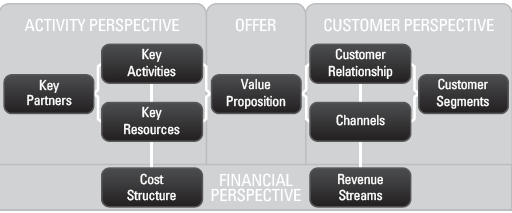Reconstructing your value proposition
The business model consists of eight key building blocks that allow you to develop a strategy to deliver value to your customers.

On the left-hand side, you think through what key partners, key activities and key resources you need to deliver your value proposition to your customers and the cost structure to do so. Putting value in your value proposition is key to organizations differentiating themselves from the competition. According to the sales performance Miller Heiman, “to survive in this experience economy, businesses must orchestrate memorable events for their customers; and that experience itself becomes the product.”
Alexander Osterwalder is a guru in business model generation and provides concrete descriptions and questions for each building block below.
- Customer Segments – Defines the different groups of people or organizations a company aims to reach or serve. Which customer segments will you be targeting? What problem will you be solving for those customers? For whom are we creating value?
- Value Proposition – Describes the bundle of products and services that create value for a specific customer segment. What value will you deliver to your targeted customers? What package of products and services will we deliver? Why will customers buy from us?
- Channels – Describes how the company communicates with and reaches its customer segments to deliver the value proposition. How will you reach your customers? Through which channels do our customer want to be reached?
- Customer Relationships – Describes the types of relationships a company establishes or wishes to establish with a specific customer segment. What type of relationship does each of our customer segments expect us to establish and maintain with them?
- Revenue Streams – Represents the cash a company generates from each customer segment. What will customers pay for? How much will they pay? How will they pay?
- Key Resources – Describes the most important assets required to make a business model work. What are the key resources required, to deliver and execute your value proposition?
- Key Activities – Describes the most important things a company must do to make its business model work. What key activities does our value proposition require?
- Key Partners – Describes the network of suppliers and partners that make the business model work. Who are our key partners? Who are our key suppliers?
- Cost structure – Describes all of the costs incurred to operate a business model. What are the costs of your business model? Which resources and activities are the most expensive? Are your costs less than your revenue?
Assessing and possibly redefining your business model, no matter what type or organization you are, can be a powerful and enlightening part of your strategic management process. Many organizations today are redefining how they deliver value to customers yielding unprecedented success.












The customer is ineded always right. The way you present yourself to your customers can make or break your business. If your customers are not satisfied with YOUR service then you can kiss THEIR service goodbye! If you provide good customer service they will more than likely keep coming back and there’s nothing like having loyal customers.
Defines the different groups of people or organizations a company aims to reach or serve. Which customer segments will you be targeting? What problem will you be solving for those customers? For whom are we creating value?